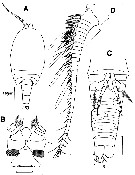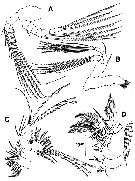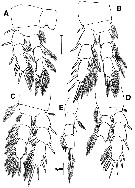|
|
 |
Fiche d'espèce de Copépode |
|
|
Misophrioida ( Ordre ) |
|
|
|
Speleophriidae ( Famille ) |
|
|
|
Archimisophria ( Genre ) |
|
|
| |
Archimisophria discoveryi Boxshall, 1983 (F,M) | |
| | | | | | | Ref.: | | | Boxshall, 1983 (p.103, figs.F,M); Huys & Boxshall, 1991 (p.92, 436, 460, figs.F,M); Boxshall & Halsey, 2004 (p.223: fig.F) |  issued from : G.A. Boxshall in Bull. Br. Mus. nat. Hist. (Zool.), 1983, 44 (2). [p.104, Fig.1]. Female (from 34°57'N, 32°55'W): A, habitus (dorsal); B, rostrum and labrum (ventral); C, urosome (ventral); D, A1 (dorsal). Scale bars 0.100 mm unless otherwide indicated. Nota: Prosome apparently 4-segmented but with 1st free thoracic somite entirely concealed beneath a carapace-like extension from the posterior margin of the maxilliped)bearing somite. Nauplius eye absent. Prominent rostrum visible from dorsal aspect, not fused to labrum. Cone organs not observed but large mass of glandular tissue present on sides of cephalosome beneath usual location of cone organs (see structure and function in Benthomisophria palliata). Urosome 6-segmented. Surface of prosome and urosome somites 1 to 5 ornamented with a reticulum of epicuticular lamellae. Urosome somite 6 without reticulate markings. Caudal rami longer than wide, armed with 2 long distal margin setae, 2 medium-length distal angle setae, a dorsal seta near the inner margin and a distally located lateral seta. Labrum small, with a posterior row of marginal denticles. A1 27-segmented. P5 uniramous, 3-segmented and positioned midventrally with inner margins almost touching at base; P6 reduced to a semicircular flap closing off the opening of the genital antrum, bearing an outer plumose seta and a short inner spine.
|
 issued from : G.A. Boxshall in Bull. Br. Mus. nat. Hist. (Zool.), 1983, 44 (2). [p.106, Fig.2]; Female: A, A2 (anterior); B, Md (anterior); C, Mx1 (posterior); D, Mxp (posterior). Nota: Md with well developed gnathobase bearing distally 2 multicusped blades, 5 strong spines and an extensive fringe of pinnules; mandibular palp comprising basis, 2-segmented endopod and 4-segmented exopod. Mx1 gnathobase with 14 distal elzements; endite 1 with 1 spiniform and 3 setiform armature elements, endite 2 with 3 spiniform elements; outer lobe rudimentary represented by 6 plumose setae on outer surface of segment; maxillulary palp biramous with 2-segmented endopod and 1-segmented exopod. Mx2 6-segmented. Mxp 8-segmented
|
 issued from : G.A. Boxshall in Bull. Br. Mus. nat. Hist. (Zool.), 1983, 44 (2). [p.107, Fig.3]. Female: A, Mx2; Male: B, habitus (dorsal); C, urosome (ventral); D, A1 (dorsal). Scale bars 0.100 mm unless otherwise indicated. Nota: A1 25-segmented, unigeniculate with the articulation between segments XIX and XX.
|
 issued from : G.A. Boxshall in Bull. Br. Mus. nat. Hist. (Zool.), 1983, 44 (2). [p.109, Fig.4]. Male: A-D, P1 to P4 (anterior); E, P5 (anteroventral). Scale bars 0.100 mm unless otherwise indicated. Nota: swimming legs 1-4 incomplete in holotype and paratype females, assumed to be similar to those for a paratype male. P5 male uniramous, 4-segmented and with bases of legs almost touching at ventral midline as in female. P6 represented by a flattened plate bearing a long outer plumose seta and a short inner spine.
| | | | | NZ: | 1 | | |
|
Carte de distribution de Archimisophria discoveryi par zones géographiques
|
| | | | Loc: | | | N Atlant. (SW off Azores) | | | | N: | 1 | | | | Lg.: | | | (606) F: 1,4-1,1; M: 1,3-1,1; {F: 1,10-1,40; M: 1,10-1,30} | | | | Rem.: | hyperbenthique.
Voir aussi les remarques en anglais | | | Dernière mise à jour : 16/09/2021 | |
|
|
 Toute utilisation de ce site pour une publication sera mentionnée avec la référence suivante : Toute utilisation de ce site pour une publication sera mentionnée avec la référence suivante :
Razouls C., Desreumaux N., Kouwenberg J. et de Bovée F., 2005-2025. - Biodiversité des Copépodes planctoniques marins (morphologie, répartition géographique et données biologiques). Sorbonne Université, CNRS. Disponible sur http://copepodes.obs-banyuls.fr [Accédé le 31 décembre 2025] © copyright 2005-2025 Sorbonne Université, CNRS
|
|
 |
 |







